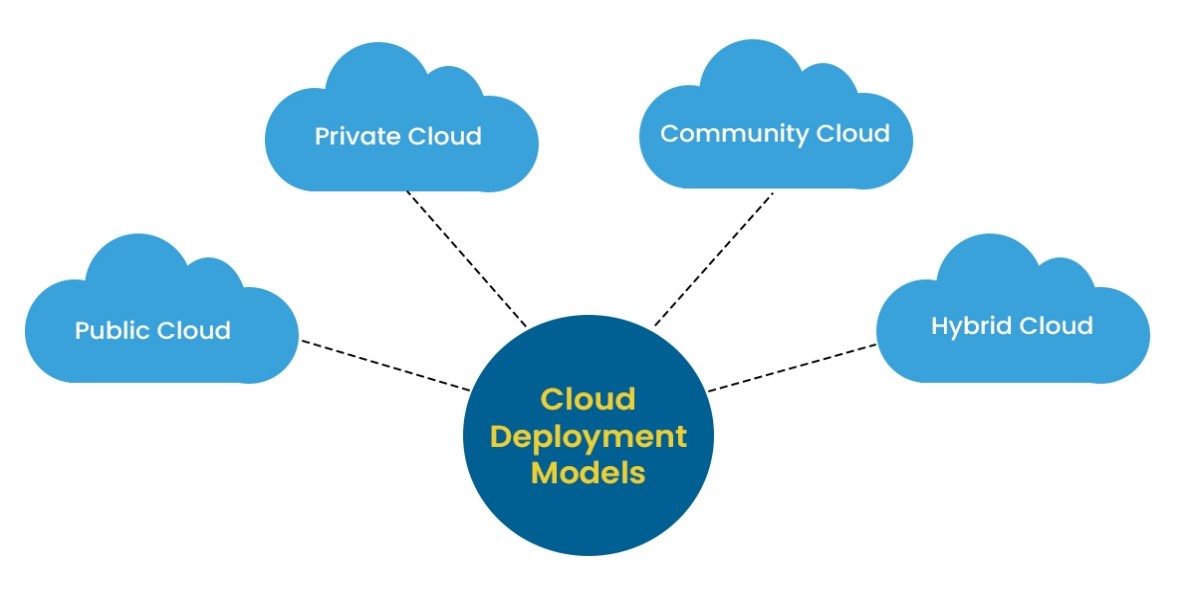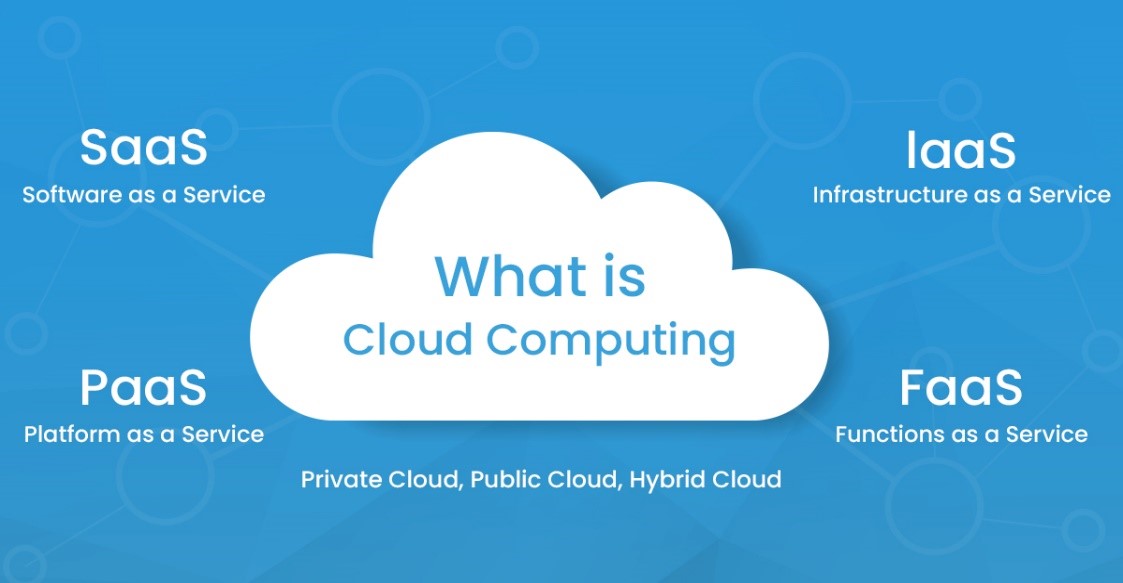Cloud Computing – Types of Cloud
Adopt the right Cloud model for your business.

What is Cloud Computing?
In one statement, Cloud computing is the delivery of on-demand IT resources over the internet. The companies that offer these computing services are called Cloud Service Providers (CSPs). CSPs charge users/organizations based on Cloud resources used through a variety of billing models. Cloud resources are the resources that are abstracted from the underlying physical hardware with the help of a Hypervisor. But there is a lot of confusion about Cloud computing because there are multiple types of services and deployment models that fall under the umbrella that is Cloud computing. This article will help you clear the basic concepts of Cloud computing.

There are 4 types of Cloud deployment models:
These deployment models differ on the basis of implementation type, hosting type and who has access to it. All Cloud deployment models are based on the same principle of Virtualization (abstraction of resources from bare metal hardware) but differ in terms of location, storage capacity, accessibility, and more. Depending on the type of data you are working with, you will want to compare Public, Private, Hybrid, and Community Clouds in terms of different levels of security they offer and the management required.
- Public Cloud
The entire computing infrastructure is located on the premises of the CSP that offers Cloud services over the internet. This is the most economical option for those individuals/organizations that do not wish to invest in IT infrastructure. In a Public Cloud environment, the resources are shared between multiple users who are also called ‘Tenants’ The cost of using Cloud services is determined through the usage of IT resources consumed.
- Private Cloud
Individuals/organizations that choose Private Cloud gets dedicated infrastructure that is not shared by any other individual/organization. The security and control level is highest while using a private network. The costs are born by an individual/organization and are not shared with any other individual/organization. Management of Private Cloud is taken care of by the user and the CSP does not provide any Cloud management services.
- Hybrid Cloud
This Cloud deployment model includes the characteristics of Public Cloud and Private Cloud. Hybrid Cloud allows the sharing of data and applications between Public and Private Cloud environments. Organizations mainly use Hybrid Cloud when their On-Premise infrastructure needs more scalability, so they make use of scalability on Public Cloud to meet fluctuating business demands. Organizations can keep their sensitive data on their Private Cloud when reaping the power of the Public Cloud.
- Community Cloud
A Community Cloud is a Cloud infrastructure that is shared by users of the same industry or by those who have common goals. This Cloud infrastructure is built after understanding the computing needs of a community as there are many factors including compliances and security policies which need to be included in the community Cloud infrastructure.
Who can benefit from Cloud Computing?
Organizations from the below verticals can benefit through Cloud Computing:
- Banking & Finance
- Government
- Manufacturing
- Healthcare
- Education
- Pharmaceutical
- Transport
- Real estate
- IT/ITES
Quick Links
1. The Fundamentals of Cloud Computing
2. IaaS vs. DaaS vs. PaaS vs. SaaS – Which Should You, Choose?
3. Different Types Of Data Centers And Their Different Tasks
4. Cybersecurity in The Cloud: Here’s What It Means
5. The Survival Story of Badal Singh’s Heaven Enterprises
Further, the Cloud service models are classified as:
- IaaS (Infrastructure-as-a-Service)
- PaaS (Platform-as-a-Service)
- SaaS (Software-as-a-Service)
- or, Storage, Database, Information, Process, Application, Integration, Security, Management and Testing-as-a-service

Types of Cloud services: IaaS, PaaS, SaaS and FaaS

Cloud computing services fall into 3 main categories: Infrastructure as a Service (IaaS), Platform as a Service (PaaS), and Software as a Service (SaaS). Functions as a Service (FaaS) is a relatively new Cloud service model. These are sometimes called the Cloud computing stack because they build on top of one another.
- Infrastructure-as-a-service (IaaS)
Infrastructure as a Service (IaaS) contains the most basic building blocks for Cloud infrastructure and offers services on tops of it such as renting IT infrastructure (virtual or physical) and networking features. IaaS mainly includes Cloud-based services on a pay-as-you-go model. A user pays for computing services on IaaS because it is the fundamental platform to build new technologies.
- Platform as a service (PaaS)
Platform-as-a-service (PaaS) refers to the supply of on-demand tools for developing, testing, delivering, and managing software applications. PaaS delivers a framework for developers and IT architects to create web or mobile apps that are scalable, without worrying about setting up or managing the underlying infrastructure of servers, storage, network, and databases needed for development.
- Software as a service (SaaS)
Software-as-a-service (SaaS) is a method for delivering on-demand software applications through Cloud on a subscription basis. A CSP takes care of managing the Cloud infrastructure and offers SaaS applications over the internet to a user that are accessible through a web browser. These applications are also available on multiple devices which can be accessed from anywhere.
- Functions as a Service (FaaS)
Functions as a Service (FaaS) adds another layer of abstraction to PaaS so that developers are completely isolated from everything in the stack below their code. FaaS is the concept of Serverless Computing. Instead of handling the hassles of virtual servers, containers, and application runtimes, they upload narrowly functional blocks of code and set them to be triggered by a certain event. FaaS applications consume no IaaS resources until an event occurs, reducing pay-per-use fees.
Go through the below chart which simply explains difference in each Cloud delivery model

Uses of Cloud computing
Although you do not realize you are probably using Cloud computing right now, there are many services that we use on a day-to-day basis such as sending emails, editing documents, streaming movies, etc. There are high chances that a Cloud platform is making all this possible behind the scenes.
Today, a variety of organizations ranging from startups to government institutions, are embracing Cloud technology for the following reasons:
- Create new apps and services
- Store, back up, and data recovery
- Hosting websites and blogs
- Stream audio and video
- Deliver on-demand software services
- Analyze data for patterns through the integration of advanced technologies
- Make predictions

Cloud Service Providers offer Cloud and data center services that let an organization choose from desired Cloud services and deployment models as per their requirements. ESDS Software Solution is a leading CSP in India that provides a managed cloud and data center services. ESDS has innovated its own Cloud platform, eNlight Cloud, which has Patented Vertical Auto Scaling technology and benefits businesses by being an agile platform to support varying workloads.
eNlight Cloud offers Public, Private, Hybrid, and Community deployment models that are pre-defined for a specific use. ESDS is the pioneer of Community Clouds in India that are industry-specific Cloud platforms for Government, BFSI, Enterprise, and SAP verticals. Through the SPOCHUB marketplace, ESDS offers SaaS and PaaS solutions to industries on a subscription and pay-per-use basis.
- Why you should choose Cloud Managed Services - May 14, 2021
- Understanding SAP BASIS Support - January 27, 2021
- Cloud Computing – Types of Cloud - January 18, 2021

Thanks for sharing the information regarding Cloud Computing this will really helpfull for me
Nice article! It's very helpful and useful Cloud computing is often used as a generalized term, but it's important to know the different types available.
Rich content
Hi,
Thanks for sharing this articles its easy to understating .
helpful article…
Good article
Great web site. Plenty of useful info here. I’m sending it to several friends and also sharing in delicious. And certainly, thanks in your sweat!